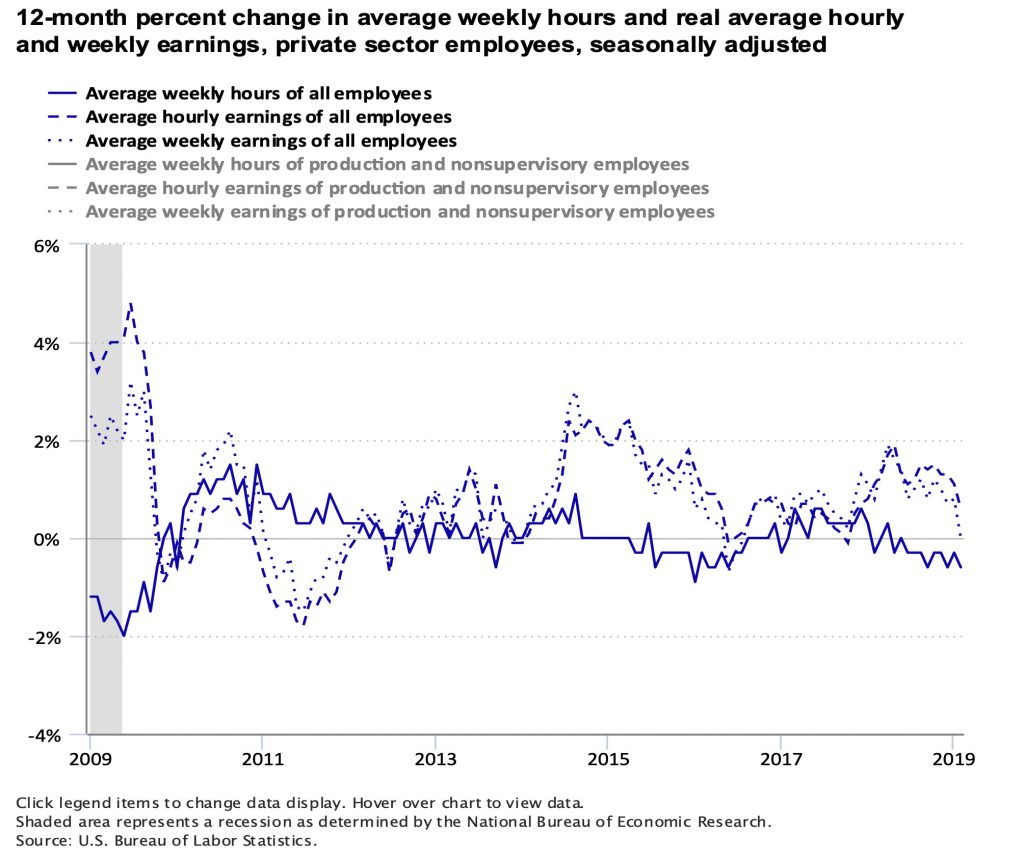
This blog will take a look at real wage growth in the United States and look at real wage growth from a variety of perspectives and different time frames. Real wage growth adjusts the nominal (actual) wage growth for inflation. In other words, it measures the purchasing power change in wages. Generally, it’s one of those topics that is interesting to most people – because real wage growth (or lack thereof) pretty much affects every worker’s standard of living. The U.S. is currently experiencing the longest economic expansion in its history and unemployment is at a 50-year low – what about wages?
In January 2020 the U.S. Bureau of Labor Statistics released data on the 12-month percentage change in average hours worked and real average hourly and weekly earnings for the past 10 years. Six different categories of data are available. Chart 1 below shows the 12-month percentage change for three selected categories: 1) average real hourly earnings of all employees (on private nonfarm payrolls), 2) average weekly hours of all employees, and 3) average real weekly earnings of all employees.
CHART 1

Over the past decade, the highest percentage 12-month change in average real hourly earnings for all employees occurred in 2015. After declining following the financial and economic crisis of 2007 – 2009, the 12-month change in average hourly earnings gradually increased and peaked at over 2% in 2015. The 12-month percentage change slowed in 2016 and growth was less than 1% in 2017. Real hourly earnings growth increased to nearly 2% in February 2019 before hitting a 2019 low of 0.6% in December 2019.
Average weekly hours worked by all employees was up and down over the past decade. Following the financial and economic crisis, hours worked generally increased through late 2015. However, declines occurred in 2016 and 2017 before increasing again in 2018. Declines in average weekly hours occurred consistently in 2019 beginning in January.
The change in average weekly hours worked combined with changes in average real hourly earnings determines the change in real average weekly earnings. From November 2012 through December 2016 real average weekly earnings consistently grew, with growth peaking at 3.0% on February 2015. Real average weekly earnings declined January through March of 2017, before increasing throughout 2018 and 2019 and peaking at 1.9% in January 2019. The decline in average weekly hours can offset the gains of wage growth. Real average hourly earnings for all employees increased 0.6 percent from December 2018 to December 2019. The change in real average hourly earnings combined with a 0.6-percent decrease in the average workweek resulted in essentially no change in real average weekly earnings over this period.
In sum, the 12-month change in average real hourly earnings has consistently increased since 2013. The increases have generally been less than 2%, peaking at 2.4% in October 2015. In 2019, the 12-month change in average real hourly earnings peaked at 1.9% in February. The increase in growth has declined since August, falling to an increase of 0.6% in December. Factoring in changes in average weekly hours worked yields the change in real average weekly earnings. Real average weekly earnings have generally increased since 2014, with growth peaking at 3.0% in February 2015. A brief period of declining weekly earnings occurred in January and February 2017 before a return to growth. In 2019, the 12-month change in average real average weekly earnings was essentially no change, the low for the year as a slight decline in the average workweek offset a slight gain in real average hourly earnings.
That’s the overall picture for wage and earnings growth over the past decade. The next parts of this blog will break down the long-term numbers for real wage growth by various demographics and income percentiles across different time periods. That will provide some insight as to who saw real wage growth – and who didn’t.
CBEI Blog Series: Real Wage Growth (or Lack Thereof)
Part 1: The Last Decade
Part 2: The Long Run: 1979-2018
Part 3: By Decade
Part 4: Economic Growth, Unemployment and Wage Growth

Kevin Bahr is a professor emeritus of finance and chief analyst of the Center for Business and Economic Insight in the Sentry School of Business and Economics at the University of Wisconsin-Stevens Point.
